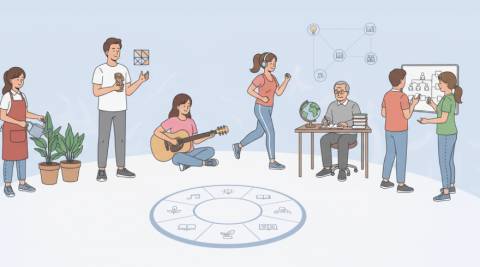The Definitive Guide to Multiple Intelligences Assessments

Understanding Gardner’s Theory and Its Modern Relevance
For decades, the conversation about human capability was dominated by narrow measures that conflated achievement with a single numeric score. Howard Gardner’s framework disrupted that paradigm by proposing a constellation of distinct abilities, each representing a different way people process information and solve problems. Linguistic expression, logical analysis, spatial reasoning, bodily-kinesthetic coordination, musical perception, interpersonal attunement, intrapersonal insight, and naturalistic awareness together form a richer mosaic of talent. Rather than ranking individuals, this perspective emphasizes context, task demands, and personal preference, which is far closer to the complexity of learning and work in real life. As a result, educators, parents, coaches, and team leaders gained a practical lens for identifying strengths, nurturing potential, and designing environments that empower diverse thinkers.
Today, the approach resonates beyond classrooms, supporting workforce development, coaching engagements, and community programs that value authentic strengths. In classrooms worldwide, educators rely on a multiple intelligences survey to map learner profiles and personalize instruction, turning abstract theory into meaningful action. That alignment between theory and practice is what keeps the model relevant in a world where adaptability and collaboration matter as much as technical expertise.
How the Questionnaire Works, What It Measures, and Sample Items
Well-constructed instruments that profile multiple abilities tend to use clear statements and a consistent response scale so participants can indicate how strongly each statement reflects their tendencies. The goal is to capture patterns across domains, not to label someone as “good” or “bad” at anything. Scores are aggregated to form a nuanced profile that can guide goal-setting, course selection, and project roles. Importantly, high-quality tools avoid leading language, include reverse-coded items to reduce response bias, and are piloted with diverse groups to verify clarity. When participants see examples connected to daily tasks, they can respond more accurately and confidently, yielding results that are more useful for reflection and planning.
| Intelligence | Typical Indicators | Sample Prompt | Practical Applications |
|---|---|---|---|
| Linguistic | Enjoys reading, wordplay, persuasive writing | “I find it easy to explain complex ideas in writing.” | Blogging, policy briefs, storytelling for presentations |
| Logical-Mathematical | Patterns, hypotheses, data manipulation | “I like to break problems into steps and test solutions.” | Data analysis, A/B testing, budgeting, diagnostics |
| Spatial | Mental rotation, visual mapping, design sense | “I sketch diagrams to clarify my thinking.” | UI mockups, architecture, GIS mapping, prototyping |
| Bodily-Kinesthetic | Hands-on learning, tactile feedback, precise movement | “I learn best by building or manipulating objects.” | Laboratory work, sports coaching, craft production |
| Interpersonal | Group dynamics, empathy, conflict resolution | “I quickly sense how others are feeling in meetings.” | Facilitation, client service, leadership, mediation |
| Intrapersonal | Self-knowledge, reflective practice, autonomy | “I keep track of my growth and adjust strategies.” | Coaching goals, independent research, habit design |
| Musical | Rhythm, pitch sensitivity, auditory patterning | “I notice subtle differences in sound and timing.” | Audio editing, music education, sound design |
| Naturalistic | Classification, systems in nature, observation | “I can recognize patterns in environments.” | Ecology projects, agriculture planning, field studies |
Reliability and validity matter immensely because insights should lead to confident decisions and fair opportunities. When designed well, an intelligence survey blends clear constructs with pilot testing and transparent scoring so users understand how results translate into action. That transparency builds trust, fosters accurate self-reflection, and minimizes misinterpretation by learners and facilitators alike.
Benefits for Learners, Educators, and Teams
Recognizing different ways of being smart fosters motivation, because people see pathways that align with their strengths rather than barriers that spotlight weaknesses. Learners who identify signature abilities can choose study strategies that fit them, from mind maps and sketchnotes to physical simulations and collaborative debates. Educators, meanwhile, can diversify instruction without abandoning rigor by rotating modalities across units, balancing text analysis with visual design, hands-on labs, and structured peer dialogue. In the workplace, managers use profiles to build complementary teams, assign roles that suit natural preferences, and design learning programs that reach every participant.
Career exploration is also more grounded when strengths are visible across varied contexts instead of a single snapshot. For career counselors, a multiple intelligence survey offers a structured starting point for conversations about transferable capabilities across industries. That clarity reduces guesswork, encourages targeted upskilling, and helps people craft portfolios that broadcast their best work.
- Improved engagement through tailored learning experiences and authentic tasks.
- Greater equity by honoring diverse talents, voices, and cultural expressions.
- Stronger teamwork sparked by complementary roles and mutual respect.
- Faster feedback loops that guide practice, reflection, and iteration.
- Better alignment between personal goals, coursework, and career pathways.
Interpreting Results Responsibly and Avoiding Common Pitfalls
Profiles should be interpreted as starting points for inquiry rather than final verdicts. A single snapshot cannot capture mood, context, or recent practice, and strengths often shift with training and feedback. Facilitators can deepen insights by triangulating results with work samples, observation notes, and reflective journals. Paying attention to how preferences interact with task demands prevents simplistic labels that hinder growth. When a learner appears evenly balanced across several domains, it might indicate broad versatility, lack of exposure, or items that did not fully resonate, which calls for follow-up conversation.
Practicality is another dimension of responsible use, especially when programs scale across cohorts and settings. Before making program decisions, try a multiple intelligence online survey alongside portfolio evidence and interviews so decisions rest on multiple data sources. That triangulation keeps the focus on authentic performance under real conditions, which is ultimately what schools and employers value most.
- Avoid labeling people with one-dimensional tags that limit opportunities.
- Review subscale balance and look for patterns over time, not just one sitting.
- Document concrete examples that illustrate how strengths show up in tasks.
- Encourage deliberate practice so interests can mature into competencies.
Choosing a Reliable Online Questionnaire and Verifying Quality
The quality of an instrument determines the usefulness of its insights, so selection deserves care and due diligence. Start by examining the clarity of constructs: each domain should be defined with language that is both precise and accessible. Look for documentation describing item development, pilot studies, reliability coefficients, and evidence of content validity. Tools that publish interpretation guides and practical next steps empower educators and learners to act with confidence. If a provider explains how scores map to recommendations, that transparency usually signals conscientious design rather than marketing fluff.
Accessibility and inclusion are equally important. Interfaces should support screen readers, keyboard navigation, and mobile responsiveness so everyone can participate. Translations must be culturally sensitive, not literal transpositions that distort meaning, and reading levels should match the intended audience. Consider data ethics as well: user consent, clear retention policies, and anonymized reporting are essential for trust. If a platform integrates with learning systems, ensure that administrators can export reports securely and that privacy settings are granular.
- Check sample items to see whether statements are concrete and non-leading.
- Verify that guidance includes study tips, project ideas, and reflection prompts.
- Pilot with a small group, gather feedback, and review score distributions.
- Confirm that the provider updates items as curricula and job skills evolve.
FAQ: Common Questions About Multiple Intelligences Test
How many intelligences are typically considered in this framework?
Most contemporary instruments address eight core domains described by Gardner, with some adding an optional existential dimension, depending on the provider and context.
Is this approach the same as learning styles?
No, the framework describes clusters of abilities, whereas learning styles refer to preferences. Abilities can be developed through practice, feedback, and purposeful challenges.
Can results change over time with training?
Yes, deliberate practice, mentoring, and rich project experiences can elevate performance in specific areas, which is why follow-up assessments and portfolios are helpful.
What age groups can use these instruments?
There are versions for children, adolescents, and adults, with wording adapted for readability and examples tailored to school, community, and workplace settings.
How should educators use the insights in the classroom?
Rotate modalities across units, offer choice in demonstrations of learning, and align projects with authentic tasks so students can showcase strengths while developing new skills.
Latest News



